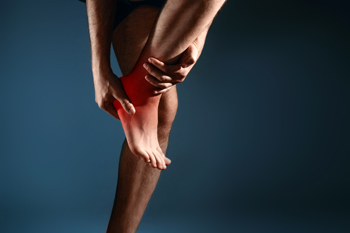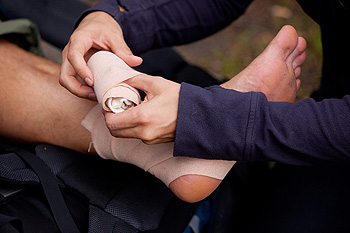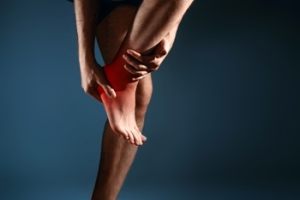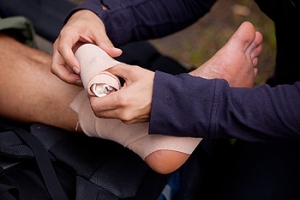Connect With Us

Foot Pain Can Happen For Different Reasons
 Foot pain is a common ailment among many patients, and there are several reasons why this can occur. Foot sprains can cause severe pain and discomfort, and can happen as a result of tearing or overstretching the ligaments. Plantar fasciitis affects the heel and arch of the foot, and it can cause difficulty walking and completing daily activities. Some patients experience tarsal tunnel syndrome, and symptoms of this condition can consist of a tingling or numbing sensation in the bottom of the foot. Charcot arthropathy of the foot can cause the bones in the foot and ankle to weaken. Any type of foot pain requires a consultation with a podiatrist, who can effectively diagnose and treat your pain.
Foot pain is a common ailment among many patients, and there are several reasons why this can occur. Foot sprains can cause severe pain and discomfort, and can happen as a result of tearing or overstretching the ligaments. Plantar fasciitis affects the heel and arch of the foot, and it can cause difficulty walking and completing daily activities. Some patients experience tarsal tunnel syndrome, and symptoms of this condition can consist of a tingling or numbing sensation in the bottom of the foot. Charcot arthropathy of the foot can cause the bones in the foot and ankle to weaken. Any type of foot pain requires a consultation with a podiatrist, who can effectively diagnose and treat your pain.
Foot Pain
Foot pain can be extremely painful and debilitating. If you have a foot pain, consult with one of our podiatrists from Lexington Foot and Ankle Center, PSC. Our doctors will assess your condition and provide you with quality foot and ankle treatment.
Causes
Foot pain is a very broad condition that could be caused by one or more ailments. The most common include:
- Bunions
- Hammertoes
- Plantar Fasciitis
- Bone Spurs
- Corns
- Tarsal Tunnel Syndrome
- Ingrown Toenails
- Arthritis (such as Gout, Rheumatoid, and Osteoarthritis)
- Flat Feet
- Injury (from stress fractures, broken toe, foot, ankle, Achilles tendon ruptures, and sprains)
- And more
Diagnosis
To figure out the cause of foot pain, podiatrists utilize several different methods. This can range from simple visual inspections and sensation tests to X-rays and MRI scans. Prior medical history, family medical history, and any recent physical traumatic events will all be taken into consideration for a proper diagnosis.
Treatment
Treatment depends upon the cause of the foot pain. Whether it is resting, staying off the foot, or having surgery; podiatrists have a number of treatment options available for foot pain.
If you have any questions, please feel free to contact our offices located in Harrodsburg, Frankfort, Georgetown, and Lexington, KY . We offer the newest diagnostic and treatment technologies for all your foot care needs.
Foot Pain
The feet, being the foundation of the body, carry all of the body’s weight and are therefore prone to experiencing pain and discomfort. If you are experiencing foot pain, it is important to determine where in the foot you are experiencing this pain to help discover the cause of it. While pain can be experienced virtually anywhere in the foot, the most common sites of foot pain are in the heel and ankle.
Heel pain can be due to a multitude of conditions including plantar fasciitis, Achilles tendinitis, and heel spurs. Pain experienced in the ankle can be a sign of an ankle sprain, arthritis, gout, ankle instability, ankle fracture, or nerve compression. In more serious cases, pain in the foot can be a sign of improper alignment or an infection.
Foot pain can be accompanied by symptoms including redness, swelling, stiffness and warmth in the affected area. Whether the pain can be described as sharp or dull depends on the foot condition behind it. It is important to visit your local podiatrist if your foot pain and its accompanying symptoms persist and do not improve over time.
Depending on the location and condition of your foot pain, your podiatrist may prescribe certain treatments. These treatments can include but are not limited to prescription or over-the-counter drugs and medications, certain therapies, cortisone injections, or surgery.
If you are experiencing persistent foot pain, it is important to consult with your foot and ankle doctor to determine the cause and location. He or she will then prescribe the best treatment for you. While milder cases of foot pain may respond well to rest and at-home treatments, more serious cases may take some time to fully recover.
Who Should Get MTP Joint Replacement Surgery?
The metatarsophalangeal (MTP) joint connects the toes to the rest of the feet. The MTP joint that is located at the base of the big toe, in particular, is a frequent site of arthritis, stiffness, and deformity. Conservative treatments, such as doing foot stretching and strengthening exercises, taking anti-inflammatory medications, or injecting steroids into the joint, are sometimes effective for managing symptoms and reducing pain. However, severe symptoms that do not respond to conservative treatments may require surgical intervention. During a joint replacement surgery, the damaged MTP joint is replaced with a prosthetic. If you are suffering from MTP joint pain, please consult with a podiatrist, who can determine the right course of treatment for you.
In certain cases, in which the patient suffers from extreme pain or damage in a joint, joint replacement surgery may be deemed useful. If you have constant pain in a foot joint, consult with one of our podiatrists from Lexington Foot and Ankle Center, PSC. Our doctors will assess your condition and provide you with quality foot and ankle treatment.
What Is Joint Replacement Surgery?
Over time, joints wear down; this can be exacerbated by diseases and conditions. Joint replacement surgery, also known as arthroplasty, is when a damaged joint is surgically removed and replaced with a prosthesis. Prostheses, which can be made of ceramic, plastic, or metal, act as joints in lieu of an actual joint. One of the most prevalent causes for joint replacement is arthritis.
Arthritis in the Foot
Arthritis can occur in any joint in the body, including in the feet. Common types of arthritis in the foot are osteoarthritis, rheumatoid arthritis, and gout. The big toe is usually where arthritis occurs in the foot; this is known as hallux rigidus.
Joint Replacement Surgery in the Foot
The most common form of joint replacement in the foot is a first metatarsophalangeal (MTP) joint placement. MTP joint replacement surgery is designed to treat hallux rigidus. Surgery is not intensive, and recovery occurs within one to two months after the procedure has been done. Overall, joint replacement surgery is a safe and effective way to treat pain in the joint of the foot.
If you have any questions, please feel free to contact our offices located in Harrodsburg, Frankfort, Georgetown, and Lexington, KY . We offer the newest diagnostic and treatment technologies for all your foot care needs.
Joint Replacement Surgery
When conservative, noninvasive treatments prove unsuccessful, podiatrists will often turn to surgery as the last line of treatment for their patients. If patients are suffering from joint pain, issues in mobility, or are seeking to correct a deformity, joint replacement surgery is an effective option. Joint replacement surgery is also successful in treating arthritis, which is the most common cause of improperly working joints.
Patients with symptoms that include joint pain, stiffness, limping, muscle weakness, limited motion, and swelling are typically considered for joint replacement surgery. Range of motion and activity post-surgery will vary between patients and depending on the specific surgery performed, the affected joint, and the damage that will need to be repaired.
Joint replacement surgery replaces the damaged cartilage and bone, the latter if required. The damaged cartilage is typically replaced with a prosthesis that is attached to the bone, allowing the implant to grow into the bone. Following surgery, the patient will typically undergo physical therapy to become familiar with movement using the replaced joint.
What Happens During an Ankle Sprain?
 A common symptom of an ankle sprain is redness and swelling after it has been twisted. It can happen as a result of stepping off of a curb unexpectedly, and this may cause the ligaments on the outside of the ankle to stretch and tear. When an ankle sprain is mild, the ankle may feel stiff, and it can be relatively stable to walk on. Bruising and tenderness may be apparent if the sprain is severe, and walking can be difficult. It is important to rest and elevate the affected foot immediately after the incident has occurred, and this may help to relieve a portion of the swelling. Some patients find it useful to wear an elastic compression wrap, and this can be beneficial in providing adequate stability as the healing process occurs. If you have sprained your ankle, please consult with a podiatrist who can properly diagnose and effectively this condition.
A common symptom of an ankle sprain is redness and swelling after it has been twisted. It can happen as a result of stepping off of a curb unexpectedly, and this may cause the ligaments on the outside of the ankle to stretch and tear. When an ankle sprain is mild, the ankle may feel stiff, and it can be relatively stable to walk on. Bruising and tenderness may be apparent if the sprain is severe, and walking can be difficult. It is important to rest and elevate the affected foot immediately after the incident has occurred, and this may help to relieve a portion of the swelling. Some patients find it useful to wear an elastic compression wrap, and this can be beneficial in providing adequate stability as the healing process occurs. If you have sprained your ankle, please consult with a podiatrist who can properly diagnose and effectively this condition.
Ankle sprains are common but need immediate attention. If you need your feet checked, contact one of our podiatrists from Lexington Foot and Ankle Center, PSC. Our doctors can provide the care you need to keep you pain-free and on your feet.
How Does an Ankle Sprain Occur?
Ankle sprains take place when the ligaments in your ankle are torn or stretched beyond their limits. There are multiple ways that the ankle can become injured, including twisting or rolling over onto your ankle, putting undue stress on it, or causing trauma to the ankle itself.
What Are the Symptoms?
- Mild to moderate bruising
- Limited mobility
- Swelling
- Discoloration of the skin (depending on severity)
Preventing a Sprain
- Wearing appropriate shoes for the occasion
- Stretching before exercises and sports
- Knowing your limits
Treatment of a Sprain
Treatment of a sprain depends on the severity. Many times, people are told to rest and remain off their feet completely, while others are given an air cast. If the sprain is very severe, surgery may be required.
If you have suffered an ankle sprain previously, you may want to consider additional support such as a brace and regular exercises to strengthen the ankle.
If you have any questions please feel free to contact our offices located in Harrodsburg, Frankfort, Georgetown, and Lexington, KY . We offer the newest diagnostic and treatment technologies for all your foot and ankle needs.
Ankle Sprains
Although ankle sprains may not be as serious as a broken ankle, they should be given immediate attention and care. An ankle sprain can lead to a significant amount of pain, as well as limited mobility. They are often characterized by the swelling and discoloration of the skin. This occurs when the ligaments are stretched beyond their limits.
The simple act of walking can sometimes cause a sprain, which makes ankle sprains a very common injury that can happen to anyone. They occur when the ankle twists in an awkward way or rolls over itself, causing a pop or snap in the tendons around the ankle. Some people are more at risk than others. These include athletes who continually push their bodies to the limits and also people who have previously suffered accidents to the feet, ankles, or lower legs.
Most of the time, an ankle sprain is not severe enough for hospital attention. There are many at-home treatment options available, including propping the leg up above your head to reduce blood flow and inflammation, applying ice packs to the affected area as needed, taking over-the-counter pain relievers and anti-inflammatory medication, using an ACE bandage to wrap and support the injured ankle, and most importantly, remaining off your feet until the ankle has fully healed.
Despite this, an ankle sprain can turn into a severe injury that might require hospitalization. If the ankle ligaments or muscles are damaged from a tear or rip, that is one sign that the sprain is severe enough for hospital attention and possibly for surgery. Even after the surgery, the recovery process can be long. You may need to have rehabilitation sessions administered by your podiatrist to get your ankle back to full health.
The severity of your sprain might become apparent if you are unable to stand or walk, consistent pain occurs over a prolonged period of time, swelling is much more severe than initially present, or if you start to experience tingling or numbness. These signs may indicate that your ankle sprain might actually be a broken ankle, an injury that requires immediate medical attention.
Although they are not completely avoidable, ankle sprains can be curbed with some preventative treatment measures. These include wearing appropriate-fitting shoes that not only provide a comfortable fit, but also ankle support. It is also recommended to stretch before doing any kind of physical activity, as this will help lower your body’s chance for an injury.
Healthy Tips for Prolonged Standing at Work
 If you work a job that requires you to stand for prolonged periods of time, you may be more at risk of developing various foot and ankle problems. Fortunately, you can take several measures to reduce this risk. When standing at work, it is suggested that you change your position with slight movements frequently. Doing short, simple foot and ankle stretches, such as rolling a ball underneath each foot or flexing and extending your feet can help maintain strength, flexibility, and circulation in your lower limbs. You should also wear properly-fitted, comfortable, and supportive shoes and socks, and stand on an anti-fatigue mat if your workplace provides one. If possible, you should also alternate sitting, standing, and walking approximately every half hour and limit the total amount of time that you stand to no more than half of the work day. To learn more about caring for your feet when you have to stand for work, please consult with a podiatrist.
If you work a job that requires you to stand for prolonged periods of time, you may be more at risk of developing various foot and ankle problems. Fortunately, you can take several measures to reduce this risk. When standing at work, it is suggested that you change your position with slight movements frequently. Doing short, simple foot and ankle stretches, such as rolling a ball underneath each foot or flexing and extending your feet can help maintain strength, flexibility, and circulation in your lower limbs. You should also wear properly-fitted, comfortable, and supportive shoes and socks, and stand on an anti-fatigue mat if your workplace provides one. If possible, you should also alternate sitting, standing, and walking approximately every half hour and limit the total amount of time that you stand to no more than half of the work day. To learn more about caring for your feet when you have to stand for work, please consult with a podiatrist.
While working on the feet, it is important to take the proper care of them. For more information about working on your feet, contact one of our podiatrists from Lexington Foot and Ankle Center, PSC. Our doctors will treat your foot and ankle needs.
Working on Your Feet
Standing on your feet for long periods of time can cause stress and pain in your feet. Your whole body may experience change in terms of posture, back pain, bunions, callouses and or plantar warts. There are ways to avoid these conditions with proper foot care, smart choices and correct posture.
Positive Changes
Negative heeled shoe – Choosing this shoe type places the heel slightly lower than the ball of the foot. These are great for overall foot health. Find shoes that fit you correctly.
Go barefoot – Our feet were not designed to be enclosed for all hours of the day. Try to periodically expose your feet to air.
Eliminate Pain
Foot Exercises – Performing simple exercises, incorporating yoga and doing stretches are beneficial. This will allow increased blood flow to the area and muscles of the foot.
Achilles tendon – Stretching the foot out flat on the floor will relax the calf muscles and tendon. These exercises can be performed almost anywhere. Make sure you add these exercises to your daily regimen.
With a little bit of this information and knowing more about foot health, you will notice changes. Foot stretches and proper footwear will help with pain and prevent further issues.
If you have any questions please feel free to contact our offices located in Harrodsburg, Frankfort, Georgetown, and Lexington, KY . We offer the newest diagnostic and treatment technologies for all your foot and ankle needs.
Working on Your Feet
Foot care is important regardless of your profession, but those who work on their feet must pay special attention. Bunions, calluses, blisters, and plantar warts are just a few of the many conditions that can arise after standing all day. While painful at their worst, these conditions can easily be avoided with the right foot care. This includes both appropriate footwear and proper posture—important elements that affect the health of your feet.
Choosing appropriate footwear means choosing a shoe that has a negative heel. This means that the heel is slightly lower than the ball of your foot, which places less of a strain. If you have a profession that requires you to be on your feet all day, investing in a pair of high-quality shoes is pertinent. High-quality shoes can be purchased from a respected manufacturer that emphasizes foot care and foot health.
Despite the regularity of wearing shoes, the feet are naturally not designed to be enclosed. Regular “barefoot” time for your feet can be beneficial for foot health. Among other methods, allowing your feet to breathe can help alleviate the pain and pressure your feet may be experiencing from being on your feet all day.
Simple foot exercises and yoga positions can help improve both the health and function of your feet. Active foot exercises that create movement will stimulate your foot’s blood flow and circulation, and yoga positions that place your feet flat onto the floor will stretch out their muscles. Yoga is particularly beneficial for your Achilles tendon and calf muscles, which are areas that can become especially problematic if not taken care of. Foot exercises and yoga positions can be easily performed every day at virtually any location and any time; whether it is at the office, at the gym, or at home right before you go to bed. Simple stretching can increase your foot health by miles.
The foot pain you experience after lengthy hours working on your feet may seem inevitable and unavoidable; in reality, however, that is not the case. Wearing proper footwear and performing simple foot exercises and stretches can help ease foot pain and allow you to truly avoid frustrating foot problems.
Your feet can easily be kept healthy with some education and a little effort. Pain that begins at the feet can eventually affect the whole body. Begin taking care of your feet now!
Arthritis Can Cause Pain in the Feet and Ankles
What Is Turf Toe?
 Turf toe occurs when the joint at the base of the big toe gets sprained as a result of a vigorous upward bend of the affected toe. It commonly occurs while playing sports such as football. When players are on artificial turf, the foot grips the ground, but the body goes forward and causes the toe to bend beyond its normal range. Signs you may have turf toe can include pain and swelling at the base of the big toe, pain and tenderness when stretching the ligament, and tenderness in the ball of the foot when pressing on it. Depending on the severity of the injury, recovery from turf toe can take approximately 3-4 weeks. Athletes who believe that they have turf toe should consult with a podiatrist for proper treatment.
Turf toe occurs when the joint at the base of the big toe gets sprained as a result of a vigorous upward bend of the affected toe. It commonly occurs while playing sports such as football. When players are on artificial turf, the foot grips the ground, but the body goes forward and causes the toe to bend beyond its normal range. Signs you may have turf toe can include pain and swelling at the base of the big toe, pain and tenderness when stretching the ligament, and tenderness in the ball of the foot when pressing on it. Depending on the severity of the injury, recovery from turf toe can take approximately 3-4 weeks. Athletes who believe that they have turf toe should consult with a podiatrist for proper treatment.
Sports related foot and ankle injuries require proper treatment before players can go back to their regular routines. For more information, contact one of our podiatrists of Lexington Foot and Ankle Center, PSC. Our doctors can provide the care you need to keep you pain-free and on your feet.
Sports Related Foot and Ankle Injuries
Foot and ankle injuries are a common occurrence when it comes to athletes of any sport. While many athletes dismiss the initial aches and pains, the truth is that ignoring potential foot and ankle injuries can lead to serious problems. As athletes continue to place pressure and strain the area further, a mild injury can turn into something as serious as a rupture and may lead to a permanent disability. There are many factors that contribute to sports related foot and ankle injuries, which include failure to warm up properly, not providing support or wearing bad footwear. Common injuries and conditions athletes face, including:
- Plantar Fasciitis
- Plantar Fasciosis
- Achilles Tendinitis
- Achilles Tendon Rupture
- Ankle Sprains
Sports related injuries are commonly treated using the RICE method. This includes rest, applying ice to the injured area, compression and elevating the ankle. More serious sprains and injuries may require surgery, which could include arthroscopic and reconstructive surgery. Rehabilitation and therapy may also be required in order to get any recovering athlete to become fully functional again. Any unusual aches and pains an athlete sustains must be evaluated by a licensed, reputable medical professional.
If you have any questions please feel free to contact our offices located in Harrodsburg, Frankfort, Georgetown, and Lexington, KY . We offer the newest diagnostic and treatment technologies for all your foot and ankle needs.







